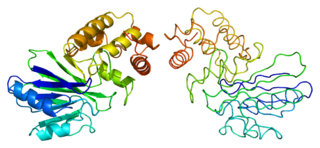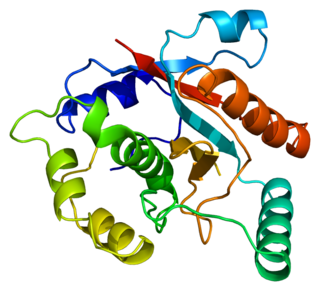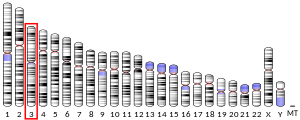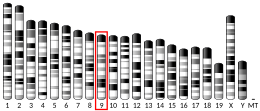
Aldolase A, also known as fructose-bisphosphate aldolase, is an enzyme that in humans is encoded by the ALDOA gene on chromosome 16.

Aspartoacylase is a hydrolase enzyme that in humans is encoded by the ASPA gene. ASPA is responsible for catalyzing the deacylation of N-acetyl-l-aspartate (N-acetylaspartate) into aspartate and acetate. It is a zinc-dependent hydrolase that promotes the deprotonation of water to use as a nucleophile in a mechanism analogous to many other zinc-dependent hydrolases. It is most commonly found in the brain, where it controls the levels of N-actetyl-l-aspartate. Mutations that result in loss of aspartoacylase activity are associated with Canavan disease, a rare autosomal recessive neurodegenerative disorder.

Eukaryotic translation initiation factor 5A-1 is a protein that in humans is encoded by the EIF5A gene.

Cathepsin L1 is a protein that in humans is encoded by the CTSL1 gene.

Protein-glutamine gamma-glutamyltransferase E is an enzyme that in humans is encoded by the TGM3 gene.

Anion exchange protein 2 (AE2) is a membrane transport protein that in humans is encoded by the SLC4A2 gene. AE2 is functionally similar to the Band 3 Cl−/HCO3− exchange protein.

Hydroxyacylglutathione hydrolase, mitochondrial is an enzyme that in humans is encoded by the HAGH gene.

Dimethylaniline monooxygenase [N-oxide-forming] 1 is an enzyme that in humans is encoded by the FMO1 gene.

Protein-L-isoaspartate(D-aspartate) O-methyltransferase is an enzyme that in humans is encoded by the PCMT1 gene.

Sialic acid-binding Ig-like lectin 7 is a protein that in humans is encoded by the SIGLEC7 gene. SIGLEC7 has also been designated as CD328.

Dipeptidase 1 (DPEP1), or renal dipeptidase, is a membrane-bound glycoprotein responsible for hydrolyzing dipeptides. It is found in the microsomal fraction of the procine kidney cortex. It exists as a disulfide-linked homodimer that is glygosylphosphatidylinositol (GPI)-anchored to the renal brush border of the kidney. The active site on each homodimer is made up of a barrel subunit with binuclear zinc ions that are bridged by the Gly125 side-chain located at the bottom of the barrel.

Bis(5'-nucleosyl)-tetraphosphatase [asymmetrical] is an enzyme that in humans is encoded by the NUDT2 gene.

Ubiquitin carboxyl-terminal hydrolase isozyme L3 is an enzyme that in humans is encoded by the UCHL3 gene.

Aminoacylase-1 is an enzyme that in humans is encoded by the ACY1 gene.

Cytosolic acyl coenzyme A thioester hydrolase is an enzyme that in humans is encoded by the ACOT7 gene.

Homeobox protein Hox-C11 is a protein that in humans is encoded by the HOXC11 gene.

Acyloxyacyl hydrolase, also known as AOAH, is a protein which in humans is encoded by the AOAH gene.

RING finger protein 139, also known as TRC8, is a protein that in humans is encoded by the RNF139 gene.

Large neutral amino acids transporter small subunit 1, also known as 4F2 light chain, is a protein that in humans is encoded by the SLC7A5 gene.

Gamma-glutamyl hydrolase is an enzyme that catalyses the following chemical reaction:





















